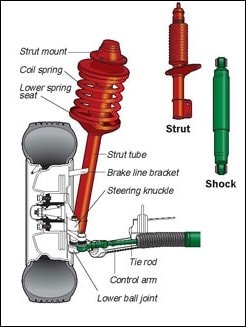When it comes to your vehicle’s suspension system, understanding the roles of shocks and struts is essential. These components are crucial for ensuring a smooth and safe ride, but they often come with a common question: do shocks and struts come together, or should they be replaced separately?
As you navigate the world of car maintenance, this question might have crossed your mind, especially when your ride starts feeling a bit rough. Imagine cruising down the highway, enjoying the scenery, when suddenly your car starts to bounce or sway more than usual.
It’s not just uncomfortable—it can also be dangerous. That’s where the condition of your shocks and struts comes into play. You might wonder if these parts, which seem to work hand-in-hand, should be replaced as a pair to maintain optimal performance and safety. We will explore the relationship between shocks and struts. You’ll learn whether it’s necessary to replace them together, and how this decision can impact your driving experience. By the end, you’ll have the knowledge to make informed decisions about your vehicle’s suspension, ensuring that each journey is as smooth and secure as possible. Dive in to discover how these components work and what you should consider for your car’s maintenance.

Credit: www.stanleysubaru.com
Do Shocks And Struts Need To Be Replaced Together
Shocks and struts serve different roles in vehicle suspension, yet they are often replaced together. This ensures balanced handling and stability. Uneven wear can lead to poor performance and increased wear on other parts.
Shocks and struts are vital components of your vehicle’s suspension system. They play a crucial role in ensuring a smooth ride and maintaining control. But do they always need to be replaced at the same time? Let’s explore this question in depth.
Understanding Shocks and Struts Shocks and struts work together but have different functions. Shocks absorb bumps, while struts provide structural support. It’s important to know their roles to make informed decisions about replacements. Signs of Wear Several indicators suggest it’s time to replace these components.
Here’s a quick list: – Bumpy ride: The vehicle feels rough over regular roads. – Uneven tire wear: Tires show unusual patterns of wear. – Leaking fluid: Visible fluid leaks around shocks or struts. – Poor handling: Car sways or bounces excessively.
Benefits of Replacing Them Together Replacing shocks and struts together can offer advantages. Consider these benefits: – Consistent performance: Ensures balanced handling and ride quality. – Saves time: One service visit for both components. – Preventive measure: Avoids uneven wear and future issues.
Situations to Replace Separately In some cases, replacing them separately makes sense. For instance: – Limited budget: Address the most worn component first. – Newer parts: If one part is recently replaced, focus on the other. – Specific wear: Only one component shows significant wear or damage.
Final Thoughts Deciding whether to replace shocks and struts together depends on several factors. Evaluate the condition, your budget, and specific vehicle needs. Seeking professional advice can also help you make the best decision.

Credit: www.counterman.com
Conclusion
Shocks and struts often work best together. They ensure a smooth ride. Replacing them at the same time can save money and time. It keeps your car balanced and safe. Old shocks and struts may cause uneven tire wear. They can also affect steering and braking.
Regular checks are important for vehicle safety. Understand your car’s needs for smoother drives. Investing in both can improve comfort and handling. Always consult a mechanic for expert advice. Keep your vehicle in top shape for reliable performance.
